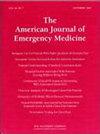影响院际转运创伤患者二次过度转运的因素:香港一项为期十年的多中心研究
IF 2.7
3区 医学
Q1 EMERGENCY MEDICINE
引用次数: 0
摘要
背景随着区域化创伤网络的发展,创伤患者的医院间转运成为创伤系统不可避免的组成部分。然而,不必要的转院是一个普遍现象,而且并非没有风险和成本。如果能更好地了解二次过度转院的情况,急诊医生就能更好地决定创伤病人的转院,并制定相关指南来支持这种决策。本研究旨在描述香港二次过度转运的模式,并确定其相关因素。方法这是对香港新界两个创伤登记中心10年(2013-2022年)前瞻性收集的多中心数据进行的回顾性研究。主要结果是二次过流,其定义为在48小时内提前出院、受伤严重程度评分(ISS)为15分、未进行外科手术。使用单变量和多变量分析比较了患者特征、生理、解剖和调查变量与二次过度转运的关系。结果在研究期间,有3852名患者接受了从非创伤中心到创伤中心的院间转运,其中809人(21%)被认为是二次过度转运。儿童年龄组的二次过度转运率较高,为 34.8%(97/279)。逻辑回归分析表明,二次过度转运与钝性创伤以及头颈部、胸部、腹部和四肢的简易损伤量表(AIS)评分为 3 分有关。然而,在香港,超过五分之一的转院被认为是不必要的,这可能被认为是资源的低效利用,并给患者及其家属带来不便。我们找出了相关因素,包括钝性创伤、头颈部、胸部、腹部和四肢的 AIS <3 评分,以及建立和改进转运协议的机会。未来应进一步研究如何安全地减少医院间转院,以提高香港创伤系统的效率。本文章由计算机程序翻译,如有差异,请以英文原文为准。
Factors influencing secondary overtriage in trauma patients undergoing interhospital transfer: A 10-year multi-center study in Hong Kong
Background
With the development of regionalised trauma networks, interhospital transfer of trauma patients is an inevitable component of the trauma system. However, unnecessary transfer is a common phenomenon, and it is not without risk and cost. A better understanding of secondary overtriage would enable emergency physicians to make better decisions about trauma transfers and allow guidelines to be developed to support this decision making. This study aimed to describe the pattern of secondary overtriage in Hong Kong and identify its associated factors.
Methods
This was a retrospective review of 10-years of prospectively collected multi-center data from two trauma registries in the New Territories of Hong Kong (2013−2022). The primary outcome is secondary overtriage, which was defined as early discharge alive within 48 h, Injury Severity Score (ISS) <15, and no surgical operation done. Patient characteristics, physiology, anatomy and investigation variables were compared against secondary overtriage using univariate and multivariable analyses.
Results
During the study period, 3852 patients underwent interhospital transfer from a non-trauma center to a trauma center, and 809 (21 %) of the transfers were considered secondary overtriage. The secondary overtriage rate was higher in pediatric age groups at 34.8 % (97/279). Logistic regression analysis showed secondary overtriage to be associated with blunt trauma and an Abbreviated Injury Scale (AIS) score of <3 for head or neck, thorax, abdomen and extremities.
Conclusion
Interhospital transfer is an essential component of the trauma system. However, over one-fifth of the transfers were considered unnecessary in Hong Kong, and this could be considered to be an inefficient use of resources as well as cause inconvenience to patients and their families. We have identified related factors including blunt trauma, AIS <3 scores for head or neck, thorax, abdomen and extremities, and opportunities to establish and improve on transfer protocols. Further research should be aimed to safely reduce interhospital transfers in the future to improve the efficiency of the Hong Kong trauma system.
求助全文
通过发布文献求助,成功后即可免费获取论文全文。
去求助
来源期刊
CiteScore
6.00
自引率
5.60%
发文量
730
审稿时长
42 days
期刊介绍:
A distinctive blend of practicality and scholarliness makes the American Journal of Emergency Medicine a key source for information on emergency medical care. Covering all activities concerned with emergency medicine, it is the journal to turn to for information to help increase the ability to understand, recognize and treat emergency conditions. Issues contain clinical articles, case reports, review articles, editorials, international notes, book reviews and more.

 求助内容:
求助内容: 应助结果提醒方式:
应助结果提醒方式:


